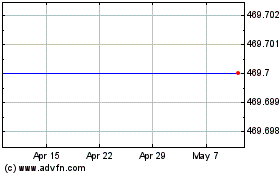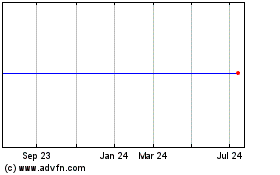By Timothy Puko
Government forecasters lowered their estimates for oil prices
and oil traders sold off Wednesday despite further signs that the
collapse of crude prices is putting long-term pressure on the U.S.
oil boom.
The country's oil production fell to a nearly one-year low and
is likely to keep falling for months longer than expected, until
next September, the U.S. Energy Information Administration said in
its monthly short-term forecast. Drilling has become unprofitable
now that crude prices have fallen by more than half since 2014's
peak, the agency said.
But for any cut coming from the U.S. and many other nations
around the world, the Organization of the Petroleum Exporting
Countries will fill the void, EIA said. It raised its expectations
for OPEC production, keeping world production virtually unchanged
through next year. It is the latest sign that there is no end for a
year-long battle to keep customers by flooding them with cheap
crude.
Those same concerns weighed on oil prices Wednesday as they have
since last summer. Light, sweet crude for October delivery lost
$1.79, or 3.9%, to $44.15 a barrel on the New York Mercantile
Exchange. Brent, the global benchmark, fell $1.94, or 3.9%, to
$47.58 a barrel on ICE Futures Europe. Both hit their lowest
settlement since Aug. 27 and are down 59% from their highs in June
of 2014.
"I don't see anything new--but just maybe a realization that the
fundamentals aren't turning around real fast," said Kyle Cooper,
managing director of research at IAF Advisors, a Houston consulting
firm. "It's still very well supplied.
"EIA left global supply virtually unchanged at 96.5 million
barrels a day for 2015 and 97.3 million for next year.
The strong supply led it to cut its price forecast for both U.S.
and global crude benchmarks. The agency said U.S. crude would
average $53.57 a barrel in 2016, down 1.6% from its previous
forecast. The U.S. price averaged $93.17 a barrel in 2014.
Brent will average $58.57 a barrel in 2016, EIA said, trimming
1.4% from the previous forecast. In 2014 Brent averaged $98.89 a
barrel.
U.S. output is down just about 5% from its April peak despite
that collapse. Output averaged 9.6 million barrels a day at its
peak in April, the highest level since 1971, and has steadily
declined since then to 9.1 million, the lowest since September
2014. Production fell by 140,000 barrels a day in August from the
prior month.
That wasn't enough to move the market, as prices held steady in
the early afternoon and fell sharply ahead of the close. Several
recent big swings came largely from speculation about how producers
and consumers will respond to prices that have fallen by more than
half since last year. It will take tangible proof of a tightening
market for any sustained rally, brokers said.
"The market wants to see the actual weekly data (on inventory)
instead of what the EIA forecasts," said Scott Shelton, broker at
ICAP PLC.
Traders have been fixated on China in recent months as worries
about an economic slowdown in the world's second-biggest economy
spilled over into crude and other commodities.
Markets got a boost early Wednesday after China's Ministry of
Finance said that it would roll out a "more forceful" fiscal policy
to stimulate economic growth, such as allocating more funds for
infrastructure projects and tax cuts for small businesses.
But after rising by more than 1%, prices spent most of the day
in retreat. With OPEC producing above its target of 30 million
barrels a day, investors say other production needs to fall to make
the market less oversupplied.
That process is likely to go on for six months longer than EIA
recently expected, its new forecast shows. It had expected output
to recover in before the spring, but now expects it to keep falling
until it hits 8.6 million barrels a day in August 2016. It lowered
its output expectations for both 2015 and 2016 by about 1.5%, to
9.2 million barrels a day this year and 8.8 million barrels a day
next year.
Saudi Arabia's crude oil output did slip in August by around
100,000 barrels a day to 10.26 million, an industry official said
Wednesday. That is still close to the record level of 10.3 million
barrels a day it hit in July. The amount of crude oil the country
sent to export and domestic markets also fell by around 80,000
barrels a day from July, according to the official.
"Any lasting price recovery would require signs that the
oversupply is being reduced," analysts at Commerzbank said in a
report.
The American Petroleum Institute, an industry group, said late
Wednesday that its own data for the same week showed an increase of
2.1 million barrels in crude-oil supplies, according to sources.
The group said that gasoline supplies rose by 700,000 barrels and
that U.S. distillate stocks increased by 800,000 barrels in the
week, according to a sources.
In refined products, gasoline futures fell 4.24 cents, or 3%, to
$1.3597 a gallon, and diesel future fell 5.52 cents, or 3.5%, to
$1.5386 a gallon.
Georgi Kantchev and Summer Said contributed to this article
Write to Timothy Puko at tim.puko@wsj.com
(END) Dow Jones Newswires
September 09, 2015 17:21 ET (21:21 GMT)
Copyright (c) 2015 Dow Jones & Company, Inc.
ICAP (LSE:IAP)
Historical Stock Chart
From Mar 2024 to Apr 2024

ICAP (LSE:IAP)
Historical Stock Chart
From Apr 2023 to Apr 2024
